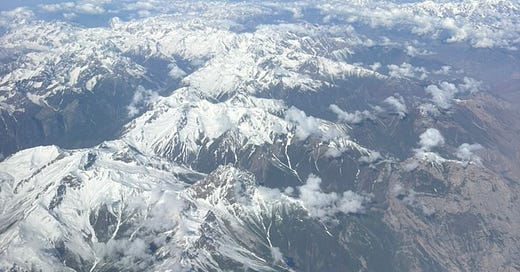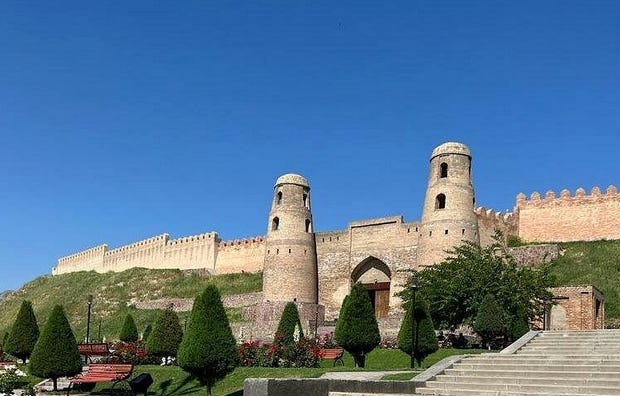On to Dushanbe
Just one of the many cities that tells the stories of the Silk Roads networks over millennia
I’ve been in Central Asia for a few days for work - so have been in Astana and Tashkent before heading over the Pamirs to Dushanbe, the capital of Tajikistan.
Nestled in the Gissar Valley, where the Varzob and Kofarnihon rivers converge, Dushanbe's strategic location made it a pivotal node in the vast network of the Silk Roads.
It’s name means ‘Monday’ in Tajik (a member of the Persian family of languages). In fact, more specifically it means ‘two days after Saturday’ (Du - meaning two; and Shanbe - Saturday).
In other words, its name comes from being home to a market that took place on Mondays. So what better time to be there than a Monday?!
We don’t know when this market first originated; but Dushanbe has been an important trade centre for more than two millennia.
In the 5th century BC, the region fell under the influence of the Persian (Achaemenid) Empire, as evidenced by artifacts such as Achaemenid dishes and ceramics discovered near the modern city.
It was then part of even wider networks that connected to the Mediterranean: Alexander the Great’s epic campaigns into Asia created interlinked networks of European, North African and Asian cultures, influences, beliefs and trade.
So it’s perhaps not surprising to those who’ve read my Silk Roads books to know that the great Greco-Bactrian kings - descendants of Alexander’s generals - who ruled parts of Egypt, Persia and the Middle East and Central Asia for centuries.
Some expanded deep into India - such as Eucratides (r. 171–145 BC) - one of whose coins has been found in archaeological digs near Dushanbe, showing the city's participation in broader Hellenistic economic systems that were part of the trade connections that have played such a crucial role in global history.
Here’s Eucratides. I’m a big fan of his hat.
Needless to say, the Greco-Bactrians only a small part of this story. Coins from the great Kushan Empire (1st–3rd centuries CE) have also been found here, in settlements like Garavkala and Shakhrinau.
The Kushans too show the Silk Roads in their glory: ‘Kushan’ is the name given to the Yuezhi nomads of Central Asia who were displaced by the Xiongnu (usually known as the Huns)
The Kushans reinforced the trade routes, and social, commerical and cultural connections of the Silk Roads with their own expansion into South Asia, as well as their links not only to Central Asia but through to China too - as well as to the Mediterranean: coins reaching India from Rome (probably by land routes, rather than by sea) were key to Kushan numismatics
By the 5th century, it was the Sogdians - the renowned merchants of Iranian descent - who dominated the Silk Road's Central Asian corridors. Their influence in what is now Tajikistan is best shown by the astonishing city of Panjikent, around 200km north of Dushanbe - and from the murals in the lavish palaces that are testimony to the wealth (and success) that came from inter-regional Silk Roads trade in late antiquity.
Chinese writers like the 7th-century pilgrim Xuanzang wrote about the vibrant markets of this region, as well as the hospitality extended to travelers, underscoring its role as a haven for merchants and monks alike. Or there is Du Huan, whose Jingxingji (written in the 8th century notes that
The kingdom of Ba-han-na [Ferghana] lies one thousand li south of the Talas; there are mountains on its eastern borders. The kingdom has several dozens of cities and several hundreds of thousands of army men stationed in these cities.
The Islamic conquests of the 8th century introduced new dynamics. Under the Samanid dynasty (819–999 CE), the region experienced a renaissance in arts and commerce, with cities like Hulbuk, with its ornate palaces and bustling bazaars, serving as examples of the prosperity that came with a new era of connections that created a world that linked Central Asia not only with West Asia and the Middle East but also with northern India, and north Africa and Spain.
Not all writers were happy about this. One of my favourite authors, Mahmud al-Kashgari, wrote in his Dīwān Lughāt al-Turk about the softness of men who turn to lives of luxury, warning that:
‘Just as the effectiveness of a warrior is diminished when his sword begins to rust, so too does the flesh of a Turk begin to rot when he assumes the lifestyle of an Iranian.’
It doesn’t look like I’ll have a chance to make it this time to the magnificent Hissar (Hisor) fort that speaks to the Silk Roads in the Mughal period as I’m in town for work.
Today’s Dushanbe is on the move - with a construction boom and lots of expensive cars on the streets - but also growing concern about global geopolitics and about water availability.
That’s why I am in town. I’ll write a separate post about that later today.
More soon.








Great post. On the topic of central asian slavery, I remember hearing William Dalrymple tell a story of central asian slavers, I can’t remember if they were kazakhs or not, in which they held their captives by tying a rope around their clavicles, so they wouldn’t escape. But I’ve never found any other reference for this, and I’m beginning to wonder if it’s actually true at all.